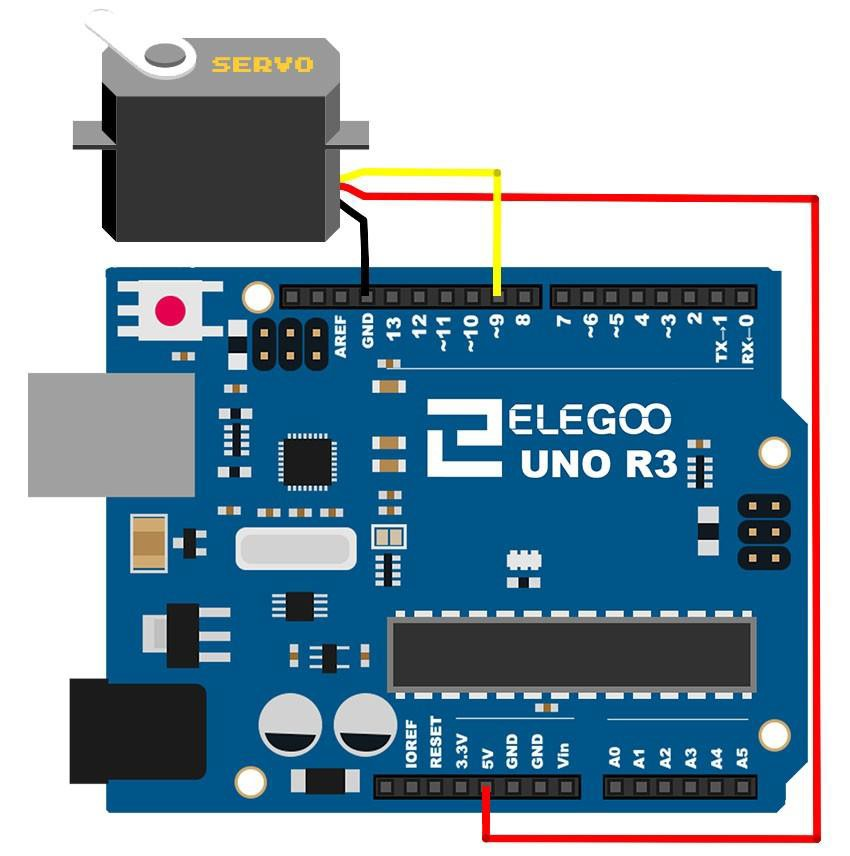

Please follow the wiring that presents in the picture, according to Arduino Uno Pinout: Sr.Ĭonnections Pins Get the Servo code and LibraryĬonnect your PC to Arduino and open Arduino IDE. As shown in the image below, the module connects with Arduino Uno. Because of the position of the servo control through the duty cycle of the pulse.

The signal pin must connect to any pulse width modulation (PWM) pin of the Arduino Uno. There are 3 pins of the servo motor, VCC connects to the +5V, Ground Connect with the GND and Signal connects with the pin 9 of the Arduino Uno. Step-by-Step Procedure Wiring Diagram of Servo with Arduino At the same time, the position detector provides a location signal to determine whether or not the set location has been reached. Then, the circuit passes the position to the swing arm through a reduction gear. The Arduino Uno board transmits a PWM signal to the servo motor, which processes it by an IC on the circuit board to compute the rotation direction to drive the motor. They are compact and can be immediately connected to an Arduino due to the built-in electronics that control their movement. Servo motors are used to precisely regulate the position of things. These pulses instruct the servo to move to a specific place. Electrical pulses, from your Arduino Uno board, can control it to the desired position. The SG90 servo motor is a geared motor that can only rotate in a 180 degrees range.
#SERVO MOTOR ARDUINO DIAGRAM HOW TO#
We’ll learn how to use the servo motor to perform 0 to 180 degrees movement by using Arduino programming. This tutorial provides the coding, wiring diagram and component list. In this tutorial, we’ll connect and use an SG90 servo motor with Arduino Uno. If you want to control multiple servo motors, you should use a servo motor controller and a separate power supply between 4.8V to 6V.( 1) To control a motion within specified degrees, such as turning a robot, the SG90 servo motor is a widely used device with Arduino, as this motor can rotate up to 180 degrees

The servo library manages much of the overhead and includes new, custom commands. Note that if you send a signal that is greater or lower than the servo can accept (for example, Firgelli linear actuators accept 1 to 2 ms), you might damage the actuator.Īnother option for controlling servos is to use the Arduino " servo library" (previously separate from the basic Arduino software, it is now included with V1.0). The relationship is linear, so use mathematics to determine the pulse which corresponds to a given angle.5V for 2500 microseconds = 2.5 milliseconds and corresponds to 180 degrees.5V for 1500 microseconds = 1.5 milliseconds and corresponds to 90 degrees.5V for 500 microseconds = 0.5 milliseconds and corresponds to 0 degrees.This pulse corresponds to a servo position, usually from 0 to 180 degrees. Servos operate by sending a timed +5V pulse (usually between 500us and 2500us) to the onboard electronics, which is repeated every ~20ms. It is best to use descriptive variables when coding to understand what each does, or the information it will contain. The term “pulse” is in black as it is not a reserved word and can be changed by the user. In this case, we called the pin “servopin” and assigned it a value of 4. This sets a pin number as dedicated input or output. Note that you also need to connect the batter's GND line to the Arduino's GND pins ("common ground"). If you want to use a more powerful servo, or if you want to connect it to a separate power supply, you would connect the battery / power supply's red (5V) and black (GND) wires to the servo's red and black wires, and connect the signal wire to the Arduino.

Connect the yellow or white wire from the servo to a digital pin on the ArduinoĪlternatively, you can plug the servo's wire into three adjacent pins, and set the pin connected to the red lead to "HIGH" and the pin connected to the black lead to "LOW".Connect the red wire from the servo to the +5V pin on the Arduino.Connect the black wire from the servo to the GND pin on the Arduino.When powering the servo directly from the Arduino board: The following example uses a standard sized servo (without any load) powered directly from the Arduino via USB. However, a servo motor may require significantly more current than the Arduino can provide. Controlling a servo motor directly from the Arduino is quite easy.


 0 kommentar(er)
0 kommentar(er)
